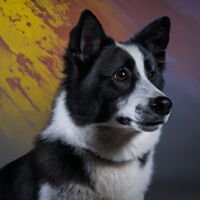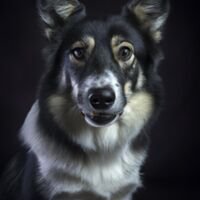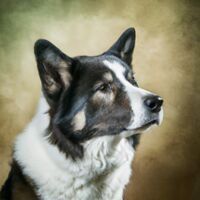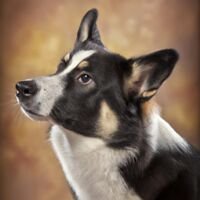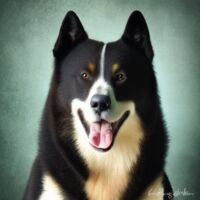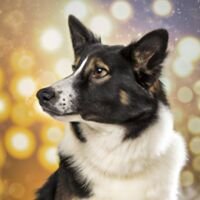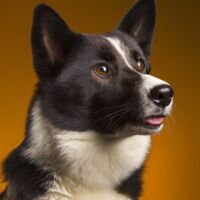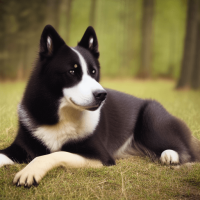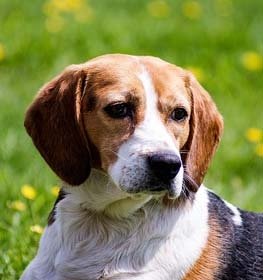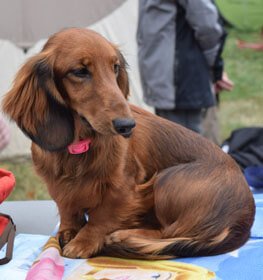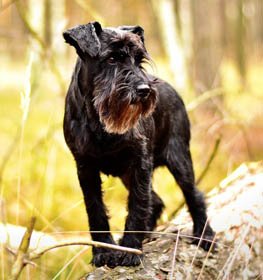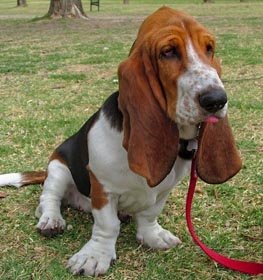Karelian Bear Dog Information & Dog Breed Facts
Collection of all the general dog breed info about Karelian Bear Dog so you can get to know the breed more.
| Group | Hunting Dogs |
|---|---|
| Popularity Rank | 304 |
| Reviews | 1 |
| User Ratings | |
|
Compare the Karelian Bear Dog With Other Dogs
Select at least one dog breed to make the comparsion. | |
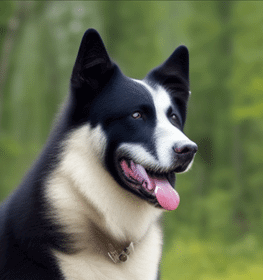 | |
| Origin | |
|
Common Names & Aliases
What other names is a Karelian Bear Dog known by? Discover all traditional, regional and informal names used for this breed. | Karelsk BjörnhundKarjalankarhukoiraKBD |
|---|---|
|
Breed Classification
What type of dog breed is a Karelian Bear Dog? Learn about its genetic classification and breeding category. | Purebred |
Photo Gallery of the Karelian Bear Dog Breed
|
Size Classification
What size category is a Karelian Bear Dog? Learn how big the Karelian Bear Dog breed typically grows. | Medium |
|---|---|
|
Weight Statistics
How much does a Karelian Bear Dog weigh? Discover typical weight ranges for adult males and females of the Karelian Bear Dog breed. | 44-50 pounds (20-23 kg) |
|
Average Weight
What is the average weight of a Karelian Bear Dog? | 47 pounds (21.5 kg) |
|
Height
How tall is the Karelian Bear Dog? Karelian Bear Dog height: | 19-23 inches (48-58 cm) |
|
Average Height
What is the average height of a Karelian Bear Dog? | 21 inches (53 cm) |
|
Price Range
How much does a Karelian Bear Dog puppy cost? Find current market prices and factors affecting Karelian Bear Dog costs. | $1000-$1200 If you choose to purchase the Karelian Bear Dog, you should know that the mentioned amount of money is an average of the collected data from breeders’ sites and puppy finder places. If you have a Karelian Bear Dog for sale, please advertise it on a reliable website to make sure the Karelian Bear Dog gets to a happy place. |
|---|---|
|
Availability
How easy is it to get a Karelian Bear Dog? How many Karelian Bear Dog are there in the world? | Average: The Karelian Bear Dog is a commonly available dog breed. There is less risk of overbreeding compared to the very popular dogs. Of course, they may be more popular in some countries, and inbreeding may occur, so be careful. |
|
Intelligence Rating
How intelligent is a Karelian Bear Dog? Discover the Karelian Bear Dog's intelligence ranking and learning capabilities. | Average: It takes patience to teach this breed any tricks or commands, but the effort is worth it. They understand and remember new commands after an average of 25-40 repetitions.
The Karelian Bear Dog ranks average in the intelligence ranking of dogs. |
|---|---|
|
Training Difficulty
How easy is it to train a Karelian Bear Dog? Learn about the Karelian Bear Dog's trainability and response to training methods. | Karelian Bear Dog dogs are easy to train. They find out the association between commands and actions quite quickly. |
|
Watchdog Rating
How good is a Karelian Bear Dog as a watchdog? Learn about the Karelian Bear Dog's alertness and guarding instincts. | Karelian Bear Dog dogs are good watchdogs. Their main job is to observe and they're consistent in their effort. Good vocal cords and a sense of hearing belong to them. Usually, they're territorial and protective about their property, so the Karelian Bear Dog dogs will alert you if they sense something different.
|
|
Territorial Protection
Is a Karelian Bear Dog protective of its territory? Learn about the Karelian Bear Dog's guarding instincts and behavior. | Karelian Bear Dog dogs are extremely protective guard dogs. This breed doesn't hesitate to protect its territory so the Karelian Bear Dog can be a good choice if you want an excellent guard dog. Keep calm and the Karelian Bear Dog will take care of unwanted people or animals. |
|
Personality Traits
What personality does a Karelian Bear Dog have? Learn about characteristic Karelian Bear Dog temperament and behavior traits. | IndependentLoyalTerritorialTenaciousBraveCautious |
|---|---|
|
Sensitivity Level
How sensitive are they? Karelian Bear Dog sensitivity: | They are a little bit more sensitive than other dog breeds. Soft punishment affects them emotionally. Karelian Bear Dog dogs don't tolerate irregular daily routines, noisy households, and frequent guest visits really well.
They are receptive to their owner's emotions and make wonderful family companions. |
|
Affection Level
How affectionate are they? Is a Karelian Bear Dog a good family dog? | High: Karelian Bear Dog dogs are genuinely loyal, soft and gentle, loving, and affectionate dogs toward their handlers. They enjoy quality time with their owners despite the activity and are considered great therapy dogs for those in need. This breed responds strongly to their handler's emotions because they bond closely. Their happiness is your happiness. |
|
Social Needs
How much social interaction does the Karelsk Björnhund need? Karelian Bear Dog social needs: | Karelian Bear Dog dogs need a lot of social interaction. They desire to always be with someone or around people. This breed hates being left alone. |
|
Impulse to Wander or Roam
How likely is the Karelian Bear Dog to run away? Does this breed explore or wander a lot? Does Karelian Bear Dog roam? | Karelian Bear Dog dogs have high wanderlust potential, which means that this breed has a strong desire for exploring the world. Safer to walk them on a leash unless you teach them how to get back to you on command. This breed is also able to cause damage to your fence. |
|
Prey Drive
Do this canine have a strong prey drive? Does Karelian Bear Dog have high prey drive? | Karelian Bear Dog dogs have a high impulse to chase and catch something. Cats or any other small animals are in danger. It's a natural instinct, doesn't necessarily mean that Karelian Bear Dog dogs are aggressive. Better to keep this breed on a leash. |
|
Barking Frequency
Does a Karelian Bear Dog bark a lot? Learn about typical Karelian Bear Dog vocalization patterns and triggers. | Average: The Karelian Bear Dog barks occasionally. They can change their barks depending on their emotional level and what they're trying to say. Different barks could mean the same and the same barks could have different meanings.
Top reasons for barking: protection, alarm, fear, boredom, attention-seeking, greeting, separation anxiety, compulsive barking. |
|---|---|
|
Playful Nature
How playful is a Karelian Bear Dog? Understand the typical play drive and energy level of the Karelian Bear Dog breed. | The Karelian Bear Dog is a playful breed. Excited barking and sometimes nipping will alert you to play. |
|
Apartment Adaptability
Can a Karelian Bear Dog live in an apartment? Learn about the Karelian Bear Dog's suitability for apartment living. | It is not recommended to keep the Karelian Bear Dog breed in the home. It does best in the garden, but if you do want to keep it indoors, it should be exercised thoroughly with long daily walks, so you can keep the Karelian Bear Dog indoors by introducing daily routines. |
|
Lifestyle Adaptability
How adaptable is a Karelian Bear Dog to lifestyle changes? Learn about the Karelian Bear Dog's flexibility to new situations. | Karelian Bear Dog dogs adapt well to lifestyle changes and different living environments. They don't mind moving from one place to another with their owner. |
|---|---|
|
Alone Time Tolerance
Can a Karelian Bear Dog be left alone? Learn about the Karelian Bear Dog's tolerance to solitude. | Karelian Bear Dog dogs tend to have separation anxiety when their owners left them alone at home because they bond very closely with them. |
|
Bite Risk Assessment
What is a Karelian Bear Dog biting potential? Learn about the Karelian Bear Dog's bite risk factors. | Low 🔽 The Karelian Bear Dog has a low chance of biting somebody. Top reasons for dog bite: protection, pain, excitement, herding instinct, being provoked. (Data based on the available online bite statistics.) |
|---|---|
|
Mouthing Tendency
Is a Karelian Bear Dog mouthy? Learn about the Karelian Bear Dog's tendency to use mouth during play. | Karelian Bear Dog dogs have a higher than average tendency to nip, chew, playbite, or herd people. It's a common habit during puppyhood, not aggressive behavior. These "bites" don't hurt, but Karelian Bear Dog dogs need to be taught a good attitude. |
|
Bite Strength Rating
How strong is a Karelian Bear Dog bite? Learn about the Karelian Bear Dog's bite force measured in PSI. | Between 200 and 400 PSI ⏺ Karelian Bear Dog bite force: Ordinary. Bite force Karelian Bear Dog measurements typically fall within the range of 200 to 400 PSI. The bite force of a Karelian Bear Dog is considered ordinary when compared to other dog breeds, but it is still quite powerful. This Karelian Bear Dog bite force PSI can cause bite wounds. Karelian Bear Dog bite PSI is not something that should be feared if the dog is well-trained and managed. To avoid any issues, it's essential to learn how to train a Karelian Bear Dog puppy not to bite from an early age.
The Karelian Bear Dog, and many others, have a fearsome presence because they have significant jaw strength, so it is important not to anger the dog and have it around strangers until it is fully trained. However, they are usually quite calm and good companions, they work well in families and are easy to care for. In conclusion, while the Karelian Bear Dog bite force is certainly an interesting aspect of the breed, it is important not to let it overshadow the many other reasons why these dogs are so loved and respected. With proper training and socialization, a Karelian Bear Dog can be a loyal and protective companion for your family. |
|
Average Lifespan
How long does a Karelian Bear Dog live? Learn about the typical lifespan of the Karelian Bear Dog breed. | 10-12 years The average lifespan of Karelian Bear Dog: 11 years |
|---|---|
|
Climate Tolerance
How well does a Karelian Bear Dog handle different weather? Learn about the Karelian Bear Dog's climate adaptability. | Prefers cold weather The Karelian Bear Dog can adapt well to harsh weather conditions, and also can be a good mountain dog. Dogs can suffer from frostbite and hypothermia in extremely cold weather, so it is important to take precautions to keep your dog safe and comfortable during the winter months. |
|
Health Concerns
What health issues are common in a Karelian Bear Dog? Discover typical conditions affecting the Karelian Bear Dog breed. | Karelian Bear Dogs tend to have a lot and frequent health issues. Regular vet check-ups are essential with this breed. |
|
Vet Care Frequency
How often does a Karelian Bear Dog need vet visits? Learn about the Karelian Bear Dog's veterinary care requirements. | Frequent The Karelian Bear Dog should have a complete physical check-up at least once (but preferably twice) per year. If your dog shows any symptoms, call your veterinarian. |
|
Health Problems
What genetic/health problems does the Karelian Bear Dog breed have? What are the health issues and concerns of the Karelian Bear Dog breed? Most common health risks of Karelian Bear Dog: | Cataracts Hip Dysplasia Progressive retinal atrophy (PRA)Skin IrritationDry SkinObesityDental ProblemsPituitary DwarfismBaldness |
|
Energy Rating
How energetic is a Karelian Bear Dog? Understand daily activity needs of the Karelian Bear Dog breed. | Karelian Bear Dog dogs have a higher energy level than other dog breeds. If you want a dog for snuggling on the couch, this breed isn't the perfect choice for you. |
|---|---|
|
Activity Requirement / Exercise Need
How much exercise does a Karelian Bear Dog need? How much exercise do Karelian Bear Dog dogs require per day?
Do Karelian Bear Dog dogs need a lot of exercises? | Karelian Bear Dog dogs need a lot of exercises. Long walks should be on a daily schedule. If you live an active life, this breed can be a good choice for you. |
|
Sleeping Need
How much sleep does the Karelian Bear Dog breed need? | Karelian Bear Dog dogs are quite energetic dogs and they don't spend too much time with sleeping. If you live an active life, this breed can be a good choice for you. |
|
Obesity Tendency
Is a Karelian Bear Dog prone to weight gain? Learn about the Karelian Bear Dog's obesity risks. | Low to Average: The Karelian Bear Dog has a low to the average risk for obesity. To make your dog happy and fit, feed him with quality dry dog food and live an active life together. Try to find the happy medium between exercise and feeding.
If you notice any weight gain, consult your veterinarian and make a diet plan. Reduce unhealthy food and snacks, and measure the Karelian Bear Dog weight regularly. |
|---|---|
|
Food Consumption
How much food does a Karelian Bear Dog need daily? Learn about the Karelian Bear Dog's feeding requirements. | 2 to 2.5 cups of a high-quality dog food daily, divided into two meals.A Karelian Bear Dog diet should be formulated for a mid-sized breed with above-average energy and exercise needs, though they often eat less than other dogs of their weight and energy level. |
|
Allergy Friendliness
Is a Karelian Bear Dog hypoallergenic? Learn about the Karelian Bear Dog's suitability for allergy sufferers. | No Karelian Bear Dog dogs don't do well with allergy sufferers by causing allergic reactions. Some dog breeds are even considered to higher possibility of an allergic response. Coat type isn't necessarily relevant, because most people are allergic to dander (flakes on the dog's skin) or saliva, not actually to dog hair. |
|---|---|
|
Coat Colors
What colors does a Karelian Bear Dog come in? Discover all possible Karelian Bear Dog color variations. | Black White |
|
Grooming Requirements
How much grooming does a Karelian Bear Dog need? Learn about Karelian Bear Dog coat maintenance requirements. | Advanced: The Karelian Bear Dog requires a lot of grooming. Cutting the dog's hair by a professional groomer can be helpful sometimes. Regular brushed dog's coat is less likely to shed. Ears and eyes should be cleaned often to avoid infections. Don't skip the seasonal flea treatment too. Occasional dog nail trimming and dog baths are important.Check the local pet store for dog grooming supplies and find the best dog shampoo to keep its coat healthy and to give your Karelian Bear Dog a pleasant experience of a dog bath. If you don't have the time, skill, or money to take care of your Karelian Bear Dog, search for the best dog groomer or clipping service in your area and book an appointment. Maybe you're lucky to have a dog boarding service that includes grooming or walk-in dog bath places nearby. |
|
Drooling Tendency
Does a Karelian Bear Dog drool a lot? Learn about the Karelian Bear Dog's drooling habits. | The Karelian Bear Dog is a perfect example of a very low drooling tendency. If you're disgusted by slobber spots on your clothes, the Karelian Bear Dog could be a perfect choice for you. Drooling is the unintentional saliva flowing outside of the mouth. It can be completely normal or a sign of a health problem. Certain dog breeds drool minimum compared to others, just like the Karelian Bear Dog.
If you notice any change in your dog's drooling habit, you should contact a vet as soon as possible. |
|
Stinkiness Rating
Does a Karelian Bear Dog smell bad? Learn about the Karelian Bear Dog's natural odor levels. | Medium ⏺ The Karelian Bear Dog has an average chance of bad smell. Top reasons for dog stinkiness: infection of bad tooth/ear/skin folds, gas attacks. |
|
Coat Characteristics
What type of coat does a Karelian Bear Dog have? Learn about the Karelian Bear Dog's fur characteristics. | Dense |
|
Bathing Needs
How often does a Karelian Bear Dog need baths? Learn about the Karelian Bear Dog's bathing requirements. | 4-6 weeks Average. Experts recommended at least every 4-6 weeks for this family pup. According to a study, 56% of pet parents don’t bathe their dogs as frequently as they should, and 60% use the sniff test when deciding when it’s bath time.
Bathing your dog is beneficial to them in more ways than just one. It’s also a good time to look for unusual scratches, bumps, fleas, and other irregularities. When their hair is wet and flat against their body, these details are more visible. |
|
Shedding Level
How much do Karelian Bear Dog dogs shed? How to control, reduce and prevent the shedding of the Karelsk Björnhund? Do Karelian Bear Dog dogs shed a lot? | Karelian Bear Dog dogs shed moderately. It's a natural process of the hair growth cycle. Regular brushing reduces the amount of hair that sheds. It mostly depends on their health status and breed type. |
|
Child Compatibility
Is a Karelian Bear Dog good with children? Learn about the Karelian Bear Dog's behavior around kids of different ages. | Karelian Bear Dog dogs are average friendly dogs towards children. |
|---|---|
|
Pet Compatibility
How well does a Karelian Bear Dog get along with other pets? Discover the Karelian Bear Dog's compatibility with other animals. | Karelian Bear Dog dogs are generally with other pets. |
|
Stranger Friendly
Are they aggressive or friendly towards/with strangers? Karelian Bear Dog temperament with other people: | Karelian Bear Dog dogs are average friendly towards strangers. |
|
Cat Friendly
How well do Karelian Bear Dog dogs get along with cats? Are they good with kittens? What is this fido's temperament with cats? Can they be good with cats? Can the Karelian Bear Dog breed live with a cat? | Karelian Bear Dog dogs are average friendly towards cats. |
|
Dog Friendly
Is Karelian Bear Dog good with other dogs? Are they dog-friendly dogs? How well do Karelian Bear Dog dogs get along with other dogs? | Karelian Bear Dog dogs are average friendly towards other dogs. |
|
Good For First Time Owners
Is Karelian Bear Dog breed good for first-time owners? Do they make a good dog for novice owners? Is Karelian Bear Dog breed suitable for first-time owners? | Yes Karelian Bear Dog dogs are good for novice owners, due to their easy-going personality. |
|
Office Friendly
Are Karelian Bear Dog dogs good office canines? Do Karelian Bear Dog dogs make good office-friendly pets? Can they be office dogs? | No Karelian Bear Dog is not the best dog breed for office environment. |
|
Senior Citizens Friendly
Are they senior citizens friendly dogs? How well do Karelian Bear Dog dogs get along with the elderly people? What is the Karelsk Björnhund temperament with senior people? Are Karelian Bear Dog dogs good for elderly owners? | Karelian Bear Dogs are commonly okay with elderly people. |
|
Service Dog Capability
Can a Karelian Bear Dog be a service dog? Learn about the Karelian Bear Dog's service work potential. | Not really This breed generally not used as a service dog. A service dog is a term used in the USA to refer to any type of assistance dog specifically trained to help people who have disabilities, such as visual impairment, hearing impairments, mental disorders, seizures, mobility impairment, and diabetes. Service dogs are protected under the ADA (Americans with Disabilities Act).
Karelian Bear Dog is not the best breed for service purposes. |
|---|---|
|
Therapy Work Suitability
Is a Karelian Bear Dog good as a therapy dog? Learn about the Karelian Bear Dog's therapy work aptitude. | Not really This breed is generally not used as a therapy dog. A therapy dog is a dog that might be trained to provide affection, comfort, and love to people in hospitals, retirement homes, nursing homes, schools, hospices, disaster areas, and people with anxiety disorders or autism.
Karelian Bear Dog is not the best breed for therapeutic purposes. |
|
Scent Detection Ability
Is a Karelian Bear Dog good at detection work? Learn about the Karelian Bear Dog's scenting abilities. | Not really They are not typically employed for this type of work, but there may be exceptional cases. A detection dog or sniffer dog is a dog that is trained to use its senses (mostly its smell) to detect substances such as explosives, illegal drugs, wildlife scat, currency, blood, and contraband electronics such as illicit mobile phones.
Karelian Bear Dog is not the best breed for detection purposes. |
|
Search & Rescue Potential
Can a Karelian Bear Dog do search and rescue? Learn about the Karelian Bear Dog's SAR capabilities. | Not really This dog breed is not typically used as a search and rescue dog. The use of dogs in search and rescue (SAR) is a valuable component in wilderness tracking, natural disasters, mass casualty events, and locating missing people.
The Karelian Bear Dog is not the best breed for SAR purposes. |
|
Maritime Work Ability
Is a Karelian Bear Dog good on boats? Learn about the Karelian Bear Dog's maritime capabilities. | Not really Karelian Bear Dog breed usually doesn't like being on a boat. Boat dogs were typically bred for their strength, stamina, and water resistance, as they were often required to perform tasks such as pulling in fishing nets, and jumping into the water to retrieve ropes or lines, or helping to move cargo. Sailor dog is a type of dog that was bred to accompany sailors on their voyages. They were typically used for three purposes: as a working dog, a watchdog, and as a companion. A boat dog is a term used to describe a type of dog that was traditionally bred and used as a working dog on boats. |
|
Draft Work Capability
Can a Karelian Bear Dog pull carts? Learn about the Karelian Bear Dog's drafting abilities. | Not really A drafting dog or draft dog is a dog bred and used for cart pulling. Dogs bred for this work have strong builds and qualities that are needed, strength and determination.
Karelian Bear Dog is not the best breed for drafting purposes. |
|
Military Service Background
Was a Karelian Bear Dog used in military service? Learn about the Karelian Bear Dog's military history. | Not really In history, this breed was not really used for combat dog. |
|
Puppy Litter Size
How many puppies does a Karelian Bear Dog usually have? Learn about typical litter sizes. | 4-8 puppies |
|---|---|
|
Pregnancy Duration
How long is a Karelian Bear Dog pregnant? Learn about the Karelian Bear Dog's gestation period. | 60-64 days Reproductive cycle of the female Karelian Bear Dog: The first period called Proestrus lasts for about 9 days.
During this time the females start to attract males. You can notice by swelling vulva and bloody discharge. The second part is the Estrus when the female is receptive for the male. It lasts for about 3 to 11 days. The sign of the proestrus part is the soft and enlarged vulva. The discharge decreases and lightens in color. The third part is the Diestrus. Normally, it occurs around day 14. In this period the female’s discharge changes for vivid red and coming to its end. The vulva returns to average, and she will no longer permit mating. The fourth part called the Anestrus. The time frame between heat periods normally lasts about six months. |
|
Breeding Frequency
How often can a Karelian Bear Dog have puppies? Learn about safe breeding intervals. | Once a year. More frequent breeding is not healthy. It is very important not to buy a dog from a puppy mill, where the needs of the pups and their mothers are ignored. It's an inhumane high-volume dog breeding facility, where puppies born several times a year. |
|
AKC Classification
What AKC group is a Karelian Bear Dog in? Learn about the Karelian Bear Dog's AKC classification. | Not recognized by the American Kennel Club. |
|---|---|
|
FCI Classification
What FCI group is a Karelian Bear Dog in? Learn about the Karelian Bear Dog's international classification. | Recognized by FCI in the Spitz and primitive types group, in the Nordic Hunting Dogs section. |
Karelian Bear Dog Pros and Cons
- Training Difficulty: Karelian Bear Dog dogs are easy to train.
- Drooling Tendency: The Karelian Bear Dog is a perfect example of a very low drooling tendency.
- Obesity Tendency: Low to Average: The Karelian Bear Dog has a low to the average risk for obesity.
- Watchdog Rating: Karelian Bear Dog dogs are good watchdogs.
- Lifestyle Adaptability: Karelian Bear Dog dogs adapt well to lifestyle changes and different living environments.
- Good For First Time Owners: Karelian Bear Dog dogs are good for novice owners, due to their easy-going personality.
- Health Concerns: Karelian Bear Dogs tend to have a lot and frequent health issues.
- Allergy Friendliness: Karelian Bear Dog dogs don't do well with allergy sufferers by causing allergic reactions.
- Apartment Adaptability: It is not recommended to keep the Karelian Bear Dog breed in the home.
- Grooming Requirements: Advanced: The Karelian Bear Dog requires a lot of grooming.
- Mouthing Tendency: Karelian Bear Dog dogs have a higher than average tendency to nip, chew, playbite, or herd people.
- Impulse to Wander or Roam: Karelian Bear Dog dogs have high wanderlust potential, which means that this breed has a strong desire for exploring the world.
- Alone Time Tolerance: Karelian Bear Dog dogs tend to have separation anxiety when their owners left them alone at home because they bond very closely with them.
- Office Friendly: Karelian Bear Dog is not the best dog breed for office environment.
Karelian Bear Dog History
Introduction
The Karelian Bear Dog prefers to be alone and can be a little grumpy. It’s alert, restless, brave, and fearless. Some people have a big ego and are eager to defend their turf. The Karelian Bear Dog enjoys standing watch and has an excellent hunting instinct.
History
The Karelian Bear Dog is said to have migrated west from the Urals approximately 900 A.D, along with the migration of the Komi, or Zyrian people. After 1100 B.C., the Komi people, who lived along the Northern Dvina River, traded with the Karelians, and the breed expanded to the area around the Lake Ladoga, particularly among the Olonets.
Over the years, it has also been seen in a territory that stretches from the Karelian Isthmus to White Karelia and as far north as Lake Kemi. According to knowledge passed down through generations, the breed was employed to hunt many sorts of wildlife, including bear, lynx, elk, deer, hare, forest bird, and waterfowl. Moreover, in 1936 the systematic breeding of the Karelian Spitz-type dog began. The idea was to create a large, powerful dog that would bark at a large game.
In Finland, it was mainly used to hunt moose. The task of the dog was to find the moose and bay it. The Karelian Bear Dog also kept frequent contact with the hunter and did not run away too far while chasing the game. They were also considered aggressive towards other dogs and often became engaged in fights, but not against humans. They were devoted and affectionate with their owners.
In May 1936, the Karelian Bear Dog made its “debut” at the first dog show of the newly formed Suomen Kennelliitto, a forerunner of today’s Finnish Kennel Club. In that same year, the breed name was approved as well. Furthermore, in 1945, the first breed characteristics were established, and a year later the first individuals were registered.
However, the outbreak of the Winter War in 1939 resulted in the near-total annihilation of the breed population. The damage was repaired during the Continuation War, however, with a substantial addition to the Karelian Bear Dog population extracted from the war zone. In total, 60 dogs were returned from Russian Karelia, with 43 of them taking part in the breeding program. For the first time in 1951, the number of registered Karelian Bear Dogs exceeded a hundred. The year 1963 was the most popular with 1021 dogs registered.
Following this, the number of registrations rapidly decreased to less than half, reaching a low point in the early 1970s. In 1992, the thousand-dog limit was again exceeded. Every year, between 700 and 1000 Karelian Bear Dogs have been recorded in the last few decades.
Appearance
The Karelian Bear Dog is a mid-sized, sturdily built, but a not heavy, dog that is powerful and only a little longer than it is tall. It has a thick coat, that is black and white with clearly defined markings. Its coat might at times, have a slight of brown. It has dark-brown eyes that are small, oval, and dark brown in color. It has a keen and alert expression. Ears are erect, medium in size, and slightly rounded at the tip. Males should be 57cm tall at the withers. Bitches have a similar figure of 52cm.
Recognition
In 1936, Finnish and Scandinavian kennel clubs recognized the Karelian Bear Dog. In appearance, the breed was very similar to the Russo-European Laika. This similarity is not accidental. Original breeding used for the development of the Karelian Bear Dog was dogged from Karelia. Laikas from Arkhangelsk Province were undoubtedly involved, as hunters brought them into Karelia on numerous occasions. As a result of their common ancestors, the Karelian Bear Dog and the Russo-European Laika are remarkably similar in look, genetics, and can be considered one breed to some extent.
Perhaps, it would not be a big mistake to consider the breed a peculiar and well-developed type of the Russo-European Laika. Today the breed is one of the top 10 most common breeds in Finland. The Karelian Bear Dog is primarily a hunting breed but can be trained for and compete in obedience trials, search and rescue trials, and sled dog trials in its native country.
However, the Karelian Bear Dog is also bred in North America and countries in Europe. The American Kennel Club does not fully recognize the breed, though it is included in their Foundation Stock Service which helps keep records of the breed’s lineage and allows them to compete in some competitions.
Latest Karelian Bear Dog Compares
Karelian Bear Dog Names
How old is my Karelian Bear Dog in human years?
You May Also Like
Rate The Karelian Bear Dog Breed
Karelian Bear Dog Comments, Reviews and Questions
- AMAZING DOG!
Dec 16, 2022, 9:09:09 PM:
very well behaved and loyal great with my teens and protective of my young son


